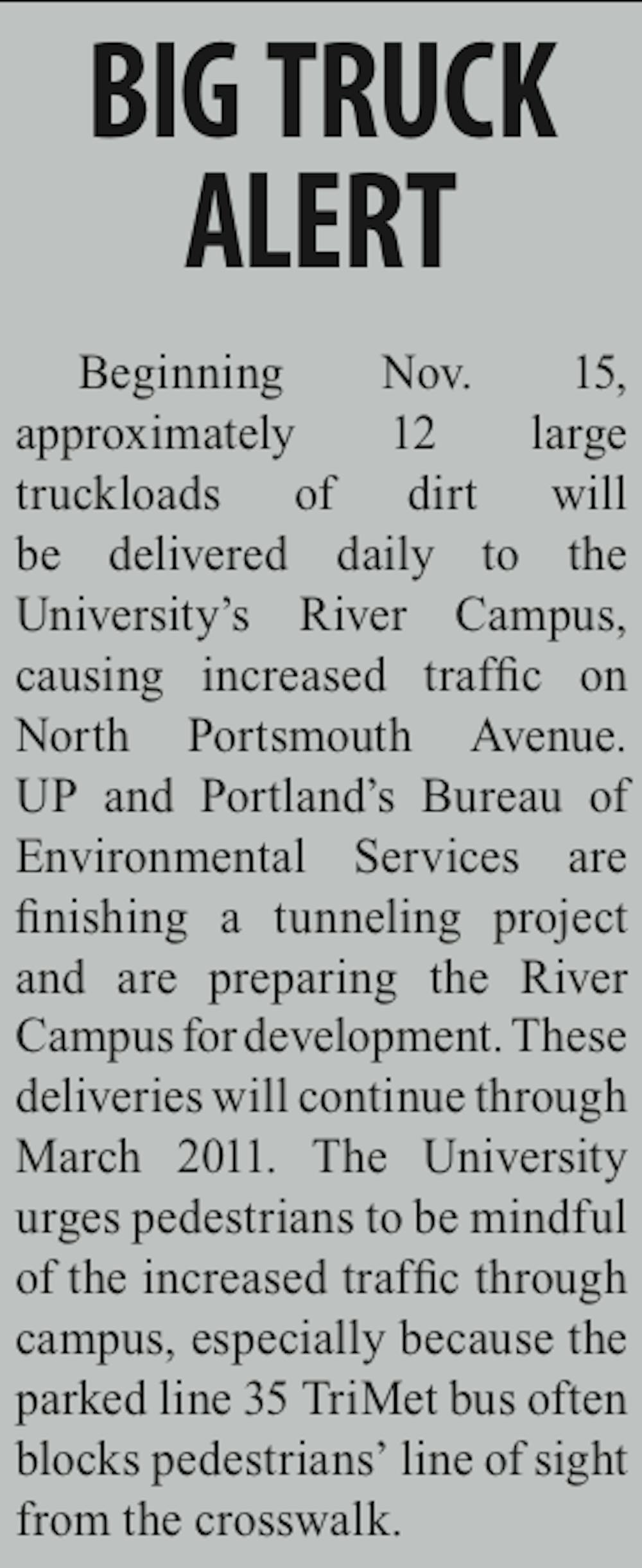Portland city leaders to review UP tree-planting proposal
(Photo courtesy of Joe Kuffner)
By Enid Spitz, Staff Writer -- spitz13@up.edu
On Nov. 17, UP will present a proposal to Portland's City Council that could bring the University a step closer to developing its River Campus, which could one day include a parking structure, sports complexes and possibly an environmental science lab.
At the hearing, the City Commission will consider UP's mitigation plan, a development agreement that would allow the University to build on protected environmental zones in exchange for creating and maintaining a natural wilderness habitat on a portion of the bluff.
UP's plan for a ‘gateway' to River Campus
In December 2008, the University of Portland finalized its purchase of the waterfront Triangle Park property, now known as the River Campus. The land used to be an industrial area, but the University hopes to transform it into an extension of the traditional campus. Before purchasing the land, UP worked with the City of Portland to change the River Campus from an industrial zone to an employment general (EG) zone, which allows for University development.
"The University has had at least for 16 years the reasonable expectation to develop there," University of Portland Assistant Vice President of Financial Affairs Jim Kuffner said.
When UP revised its conditional master plan in 1994, it included plans to construct a "gateway" structure, a parking facility on the bluff connecting the traditional campus to the River Campus 135 feet below.
UP's planned "gateway" structure would replace the main lot behind the Pilot House that is currently the University's largest parking area. The structure, to be built on the land behind Corrado Hall, would also serve as the main connection between campus as it is now and the new property.
City's environmentally-protected areas conflict with development plans
The City of Portland expanded environmental conservation and protection overlay zones along the bluff in January as part of its River Renaissance initiative, a long-term plan to revitalize the Willamette riverbank and restore its environmental habitat.
The University of Portland cannot build on City-designated environmental conservation or protection overlay zones, which are intended to preserve nature. The new overlay zones cover UP's River Campus and the land at the intersection of North McCosh Street and North Portsmouth Avenue, where UP hopes to build the "gateway" structure.
Before the City expanded the protected area, UP had little trouble developing on campus, Kuffner said.
But now, the convergence of new conservation and intended construction zones poses a problem for UP's development of the "gateway" structure.
"If they had moved it 100 feet we wouldn't be having the issue with this structure," Kuffner said.
The Mitigation Plan
To address the issue, the City Council voted 4-1 last April in favor of working with UP to create a development agreement. It requires the City and university to work out an agreement about the disputed land, host an open house for the public and eventually vote on the final agreement after public hearings set for Nov. 17 and Dec. 1.
"The primary goal of the development agreement is to reach a mutually beneficial outcome for both the University of Portland and the City representing the objectives of the River Plan," a city planner from Portland's Bureau of Development Services, Marisol Caron, wrote in a memo to Portland City Commissioner Amanda Fritz.
The University created a mitigation plan to bring before the City Council, hoping the suggested compromise would gain the City's approval and eventually lead to the construction of a "gateway" structure.
"The development agreement will include removal of the adopted environmental conservation overlay zone in the location of the Gateway building in exchange for the University providing mitigation on site," Carey explained.
The mitigation plan proposes that the University create 228,000 square feet of protected wilderness area on its River Campus to compensate for the 50,500 square feet UP's "gateway" structure would require.
"The primary purpose is to offset the predicted impact of the gateway structure in the escarpment (the bluff)," Portland's Bureau of Environmental Services representative Paul Ketcham said.
According to Ketcham, the bluff used to be the primary habitat for Oregon White Oak trees, which are now endangered and declining below historic levels. To mitigate the potential impact of the "gateway" structure, UP is offering to restore the White Oak to its habitat by planting 200 Oaks per acre across an area of the River Campus, expecting 40 to 50 per acre to reach maturity in 50 years.
In addition, the University would remove any invasive species and plant a mixed tree forest and "maple bench" wilderness area by the White Oak woodland to ensure the endangered trees' survival, collaborating with the Bureau of Environmental Services throughout the process.
"The University has a key role to play in the health of the Willamette River," Ketcham said. "It's an exciting opportunity for the University to develop and also to restore the natural habitat."
In addition to the proposal's educational and environmental functions, Kuffner expressed the desire to dedicate the woodland area to beloved UP faculty member Becky Houck, who died in September 2009, and Mike Snow, recipient of the Emeritus professor award at his retirement this year.
"I call it Becky's woods," Kuffner said.
This woodland area would be the first of its kind, according to Kuffner.
Neighborhood Reaction to the Mitigation Plan
On Oct. 21, the University hosted an open house in Buckley Center to present the mitigation plan to the larger community.
University Park Neighborhood Association chair Fletcher Tripp spoke in support of the plan at the open house.
However, Barbara Quinn, chair of Friends of Cathedral Park Neighborhood Association, voiced her disapproval at the meeting. She also wrote a critical review of the University's proposed development in The Oregonian last summer.
Calling it ironic that UP and the City would allow development on the bluff while claiming a committment to environmental sustainability, she wrote, "all the work done to increase connectivity there would be undermined by a massive impediment at the university."
Quinn would like to see UP consult the greater North Portland area about its construction plans, stating that she might support a different type of structure.
"We'd like to see something less invasive," she said.
Susan Landauer, a member of Portsmouth Neighborhood Association who agrees with Quinn, said better alternatives that would create minimal damage to the environment and look elegant from the riverside should be considered.
Quinn and Landauer also questioned the power of a mitigation plan to ensure restoration.
"The problem is that we have no real assurance," Quinn said.
They would like to see a legally-binding document created for the University, that holds it accountable for mitigation.
The Future of Development at UP
The Portland City Commission is tentatively scheduled to vote on the mitigation plan Dec. 1.
Approval of the mitigation plan does not necessarily approve the construction of the "gateway" structure. For actual development to occur, the University must revise its Master Plan and raise funding, and the land must undergo environmental review.
"It's a means to an end," Kuffner said. "We're committed to begin the mitigation plan next year, even though the building may n ot be constructed for another 10 years or so."
If the City Commission approves the plan, the University will begin planning for its White Oak wilderness area in the spring. Kuffner said the first trees would likely be planted in about three years.
According to Kuffner, the University is also currently in its first year of a projected three-year plan for cleaning the River Campus of any hazardous industrial byproducts.
If the city finds the land fit for institutional use, the wilderness area is planted, the "gateway" structure built, funds raised, and the Master Plan revised, the University of Portland can begin to further develop its waterfront property.
"By the time we reach our projected plan for development, it might be 15 or 20 years," Kuffner said.
For now, the University is focusing its efforts on its mitigation plan in preparation for the Nov. 17 review and hoping that the eventual construction of its "gateway" structure will open up a world of opportunity for the UP River Campus.
If the plan is rejected, Kuffner explained, it's back to square one.
CORRECTIONS:
The following corrections concern the Nov. 11 story about plans for River Campus and UP's proposed environmental mitigation:
The Beacon reported that building is not allowed on overlay zones. In fact, building is allowed on overlay zones if the developer and proposed development meet certain conditions.
The Beacon reported that 1994 revisions made to UP's conditional master plan "included plans to construct a ‘gateway structure,' a parking garage." A timeline accompanying the article had similar information. In fact, the 1994 plan did not propose a specific structure.
The Beacon regrets the errors.









